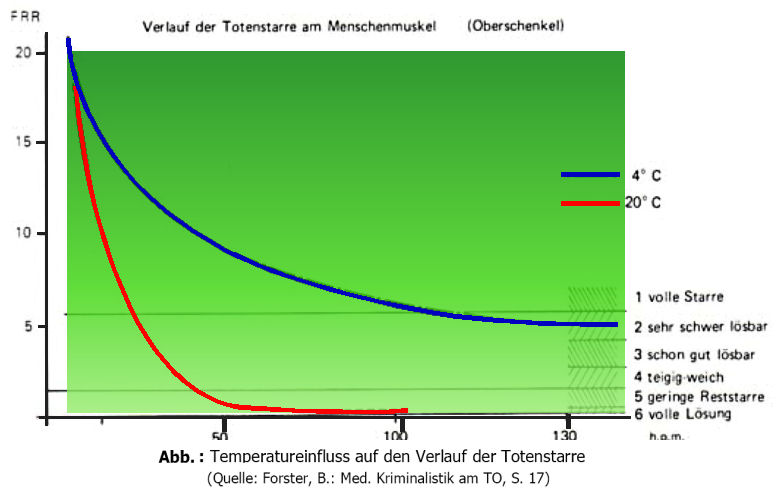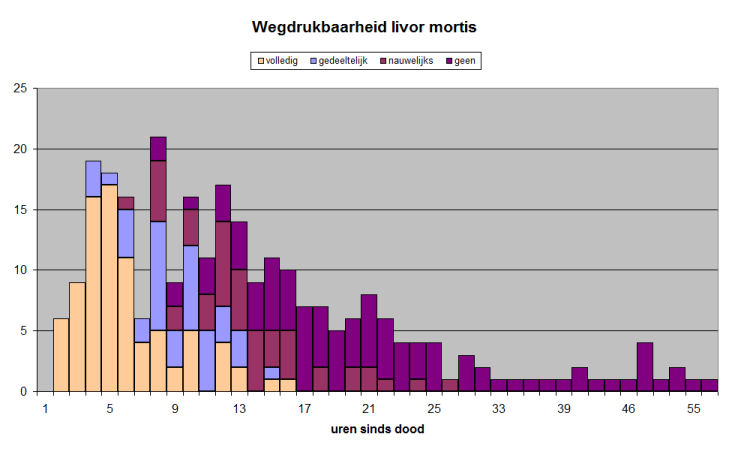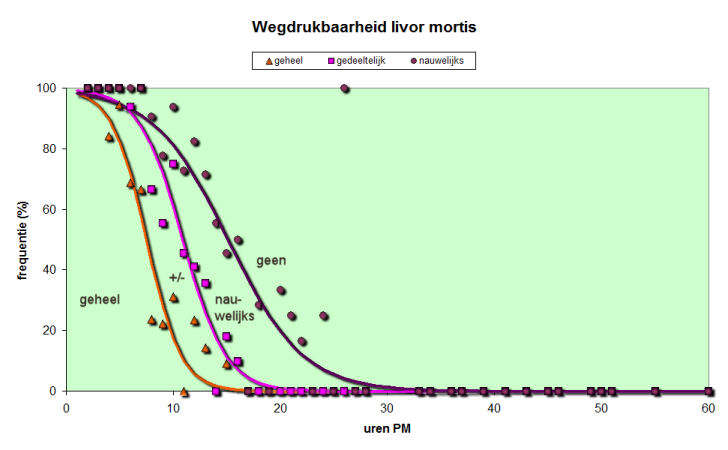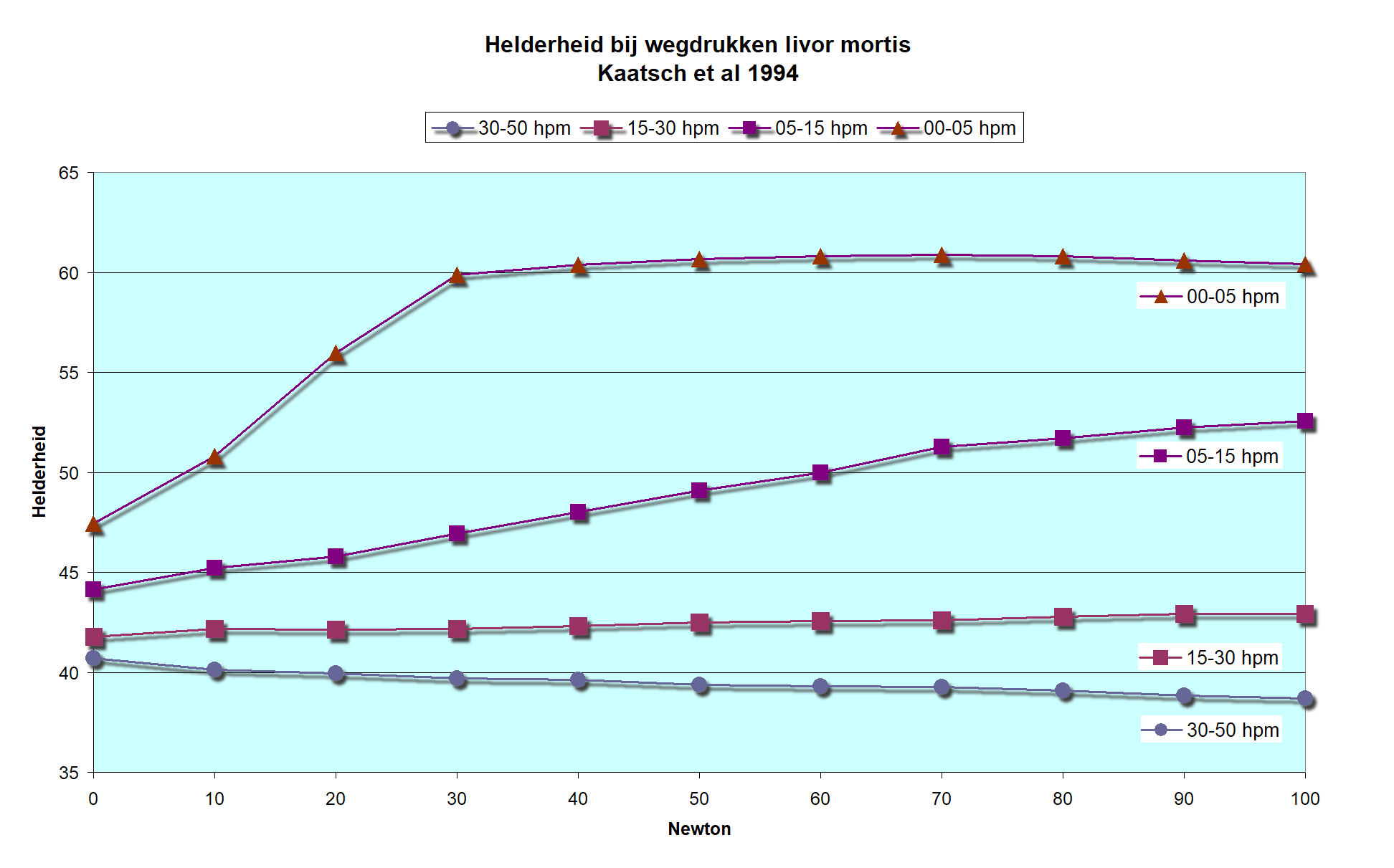| #3: |  |
Nummers verwijzen naar de pagina met literatuurverwijzingen.
#1: "Five general methods based on rectal temperature and a multiple regression analysis using rectal temperature and non-temperature based postmortem changes were applied to 212 postmortem cases of within 24h postmortem (PM) intervals. Non-temperature based postmortem changes of rigidity, hypostasis and corneal turbidity were numerically categorized and used with rectal temperatures as four statistical variables in the multiple regression analysis.(..) Although assessments of non-temperature based PM changes are mostly subjective and have a wide variation, the present study demonstrated a usefulness of non-temperature based PM changes in the estimation of PM intervals. "
#19:
|
Acceleration of onset end extent of post-mortem changes |
DMZ |
| Death occuring in a hot, moist environment/under high ambient temperatures | zomerse waarden |
| Body surface insulation by warm clothing or other covering | vest |
| Considerable time interval elapsed after death until artifactual cooling of the body | volgens rode scenario |
| Subject was overweight/had a high fat content | - |
| Subject suffered/died from underlying or sepsis | - |
| Subject was intoxicated | - |
| Subject suffered/died from open wounds | messteken en halswonden (intern) |
|
Deceleration of onset and extent of postmortem changes |
|
| Death occurred in a cold, dry environment/under low ambient temperatures | - |
| Subject was scantily dressed/naked/undressed shortly after death | - |
| Subject was stored in a cooling apparatus shortly after death | volgens groene scenario |
#2: "If full rigor is present, then one might assume that this is about the second day following death, depending upon the environmental conditions"
| #3: |  |
#4: "Onset is usually about 6 hours post mortem with disappearance between 12-36 hours. Rigor mortis disappears as a result of muscle decay."
#5: "Rigor mortis has been reported to commence, under average conditions, within three to four hours after death, and will disappear at 36-48 hours after death; however, the exact period and duration is highly variable."
#12: "This stiffening starts at the neck and lower jaw and spreads downward. Onset of rigor mortis may start from 15 minutes to 15 hours after death, but as a general rule, it starts 5 to 6 hours after death. The upper part is affected within about 12 hours and the whole body within about 18 hours. Rigor mortis usually disappears within thirty-six hours, again beginning at the head and neck and extending to the lower parts of the body. This latter process may take from 8 to 10 hours. "
#14: "Rigor starts within ½ - 1 hour after death, is complete after 6-12 hours, and disappears after 24-48 hours because decomposition causes a lysing of the bonds. "
#15: "It typically follows a predictable pattern. Rigidity begins in the small muscles of the face and neck and progresses downward in a "head-to-toe" fashion to the larger muscles. The entire process takes about 8-12 hours. At that time, the body is completely stiff and is "fixed" in the position of death. Then, the process reverses itself, with rigidity being lost in the same fashion, beginning with the small muscles and progressing to the larger ones. This process begins 18 to 36 hours after death and is usually complete within 48 hours."
#16: "Begin: 1 tot 3 uur na overlijden (variatie 0-7
uur; o.a. afhankelijk
van tonus, temperatuur en belasting van het lichaam kort voor
overlijden.
Voltooiing: na gemiddeld 8 uur (6- 10 uur)
Handhaving: 2 tot 3,5 dagen (0,5 tot 4 dagen)
Verdwijning: na 2 tot 3 dagen (1 tot 8 dagen)
De rigor begint in kleinere spiergroepen/gewrichten en van perifeer
naar
centraal. Ze verdwijnen in de zelfde volgorde."
#17: "Rigor mortis usually appears 2-4 h after death and fully develops in 6-12 h. This can vary greatly. The classical presentation of rigor mortis in its order of appearance is jaw, upper extremities, and lower extremities. Is passes off in the order in which it appeared. Rigor mortis is lost due to decomposition. In temperate climates rigor mortis disappeares in 36 h, but may be present up to 6 days."
#18:"Rigor mortis begins to show two hours after death and takes twelve hours to peak.... The stiffness remains for twelve hours and gradually disappears. After thirty-six hours, the body becomes soft again."
![[Image]](rigor_graf.jpg)
#20: "Die Totenstarre wird in mehreren Gelenken geprüft, beginnend an Kiefergelenken und Hals, anschließend an oberen und unteren Gliedmaßen. Bei Zimmertemperatur löst sich die Totenstarre nach etwa 36 bis 48 Stunden. Durch Wärme werden Leichenerscheinungen beschleunigt und durch Kälte verzögert (siehe hierzu Abb.(..))."

#2: "Refrigeration of a body already displaying typical purple lividity
will
cause it to turn pink.
After about 10-12 hours the lividity becomes "fixed" and repositioning
the
body, e.g. from the prone to the supine position, will result in a dual
pattern
of lividity since the primary distribution will not fade completely.
(..)
The blanching of post mortem lividity by thumb pressure indicates that
the
lividity is not fully fixed.
Most texts agree that lividity attains its maximum intensity at around
12
hours post mortem, but there is some variation in descriptions of when
it
first appears, and when it is well developed. "
| #3: |  |
#4: "Livor mortis , also known as hypostasis, is the process by which blood settles to the dependent portions of the body. It occurs within 2-4 hours and becomes "fixed" within 8-12 hours. It is readily apparent as a deep purple discoloration of the skin. "
#10 en #11: 268 gevallen:


#13: "The discoloration increases in intensity and usually becomes "fixed" in about 8-10 houres (..) Prior to fixation, the body can be moved many times and the blood will resettle each time into the dependent areas. (..) Patterns of livor mortis in non-dependent areas indicate the body or body part has been moved after death."
#14: "Livor starts immediately after death and continues for up to 8-12 hours. It can be used to determine if a body was moved postmortem. "
#15: "Initially, this discoloration can be "shifted" by rolling the body to a different position, but by 6 to 8 hours, it becomes "fixed." If a body is found face down, but with fixed lividity along the back, then the body was moved at least 6 hours after death, but not earlier or the lividity would have "shifted" to the newly dependent area."
#16: "Ontstaan: 1,5 tot 2 uur PM (variatie 1 tot 4
uur);
Volledig: 6 tot 12 uur PM (variatie 1 tot 14 uur);
Omkeerbaar : volledig tot 4 uur PM (variatie 1,5 tot 6 uur) onvolledig
4
tot 10 uur PM;
Wegdrukbaar: volledig tot 8 uur PM (variatie 3 tot 12 uur) onvolledig 8
tot
12 uur PM (variatie 6 tot 15 uur). "
#17:"Is usually evident within 30 min to 2 uur h after death. Lm develops gradually, usually reaching its maximum coloration at 8-12 h. At about this time it is said to become "fixed". Fixation can occur before 8-12 h if decomposition is accelerated, or at 24-36 h if delayed by cool temperatures."
#24: Mallach (1964):
|
Time course lividity according to textbooks |
average | SD |
2 x SD |
Range of scatter |
Number of quotations |
|||
|
Lower limit |
Upper limit |
Lower limit |
Upper limit |
|||||
| Development |
¼ |
½ |
- | 2 | ¼ | 3 |
17 |
|
| Confluence | 2½ | 1 | ¼ | 4¼ | 1 | 4 |
5 |
|
| Greatest distension and intensity | 9½ | 4½ | ½ | 18½ | 3 | 16 |
7 |
|
| Displacement: | ||||||||
|
1. complete on thumb pressure |
5½ | 6 | - | 17½ | 1 | 20 |
5 |
|
|
2. incomplete on sharpe pressure (forceps) |
17 | 10½ | - | 37½ | 10 | 36 |
4 |
|
| Displacement after turning body: | ||||||||
|
1. complete |
3¼ | 1 | 2 | 5½ | 2 | 6 |
11 |
|
|
2. incomplete |
11 | 4½ | 2¼ | 20 | 4 | 24 |
11 |
|
|
3. only little paler |
18½ | 8 | 2½ | 34½ | 10 | 30 |
7 |
|

Kaatsch et al. voerden
photometrische metingen uit aan het wegdrukken van livor mortis en
vonden enkele opvallende trends:
Boven een pmi van 30 uur is de livor donkerder dan ervoor en bij een
poging tot wegdrukken ervan wordt de livor gemiddeld nog donkerder.
#2: "Under average conditions in a temperate climate the earliest putrefactive changes involving the anterior abdominal wall occur between 36 and 72 hours after death. "
#4: "Stage 1: blue green discoloration of the abdomen; 24 hours (partial discoloration), 36 hours (complete discoloration). "
#13: "In general, as rigor passes, green discoloration of the skin becomes evident. The green discoloration typically begins on the abdomen and then spreads to the rest of the body. At room temperature, the right lower abdomen turns green at about 24 houres after death and the entire abdomen is green by 36 houres. (..) As discoloration progresses, the body will swell due to the production of gas by bacteria."
#14: "After 12-36 hours, a greenish discoloration will begin in the lower right quadrant. Eventually this hue will spread to the entire body. It is due to the denaturation of hemoglobin via action of the putrefaction bacteria. "
#15: " At death, the body begins to decompose. Bacteria go to work on the tissues and by 24 to 36 hours the smell of rotting flesh appears and the skin takes on a progressive greenish-red color."
#17:"Decomposition involves two processes: autolysis
and putrefaction. Autolysis
is the breakdown of cells and organs through an aseptic chemical
process
caused by intracellular enzymes.
The second form of decomposition, which to most individuals is
synonymous
with decomposition, is putrefaction. This is due to bacteria and
fermentation.
After death, the bacterial flora og the gastrointestinal tract spread
throughout
the body, producing putrefaction. This is accelerated in septic
individuals
because bacteria have already spread throughout the body prior to death.
The onset of putrefaction depends on two main factors: gthe environment
and
the body. In hot climates, the more important of these two factors is
environment.
First there is greenish discoloration of the lowe quadrants of the
adomen,
the right more than the left, usually in the first 24-36 hrs. This is
followed
by greenish discoloration of the head, neck and shoulders; swelling of
the
face due to bacetrial gas formation and "marbling". Marbling is
produced
by hemolysis of blood vessels with reaction of hemoglobin end
hydrogensulfide
ans development of greenish black coloration along the vessels. The
body
undergoes generalized bloating (60-72 h) followed bij veside formation,
skin
slippage and hair slippage. By this time, the body is a pale green to
green-black
color.(..)
This decription of the gradual decomposition of a body assumes a
temperate
environmental climate. (..)
Even in the non-septic body, if decomposition has set in, immediate
refrigeration
of the body may not necessarily stop decomposition completely. (..)
When the body came to a autopsy 6-12 h later, after having been
refrigerates
the whole time, the face was bloated and greenish black."
#5: " Loss of pressure within the eyes (intra-ocular tension) - Within 24 hours of death."
#6: "13 citaten van auteurs die het er over eens zijn, dat zwakke troebeling zich beperkt tot 12 (9 auteurs) á 24 uur (3 auteurs) en daarentegen een sterke troebeling plaatsen na (36 tot) 48 uur (3 resp. 7)."
#6 & #7: 388 gevallen:


#8: " When the cornea is transparent, the time which
has elapsed since death
is less than 36 hours, with few exceptions, with eyelids either open or
closed."
" In death from intracranial injuries and asphyxia the strong turbidity
developed
earlier than in the other types of death."
#9: "The findings whether the eyelids of cadavers are closed or open may be utilized as a criterion for estimating the postmortem interval; the cadavers with open eyelids are estimated to have been dead less than 36 hours or over 4 days."
#21: "The corneal turbidity ratio increased significantly at 8 hours after decease (p<0.01)." en: " The right and left intraocular pressure significantly related to post-mortem time and decreased gradually as time passed (p<0.05). Application of linear, exponential and power equations showed that IOP can be used to estimate post-mortem time by a two hour interval with a 95% probability."
#22: "It is found that there is a significant correlation between the corneal opacity and PMI (p<0.001)"